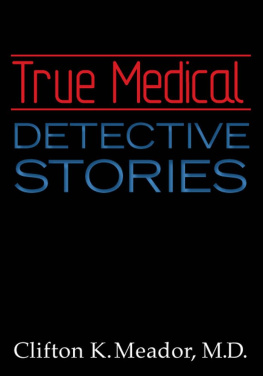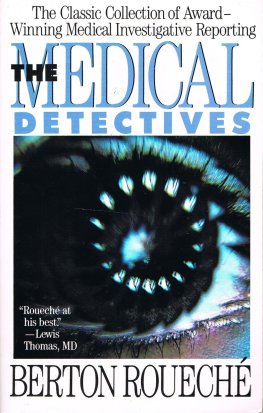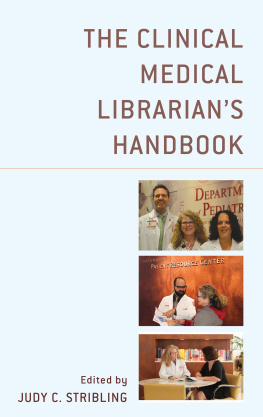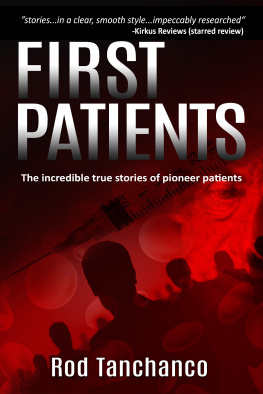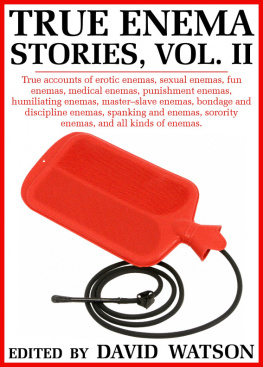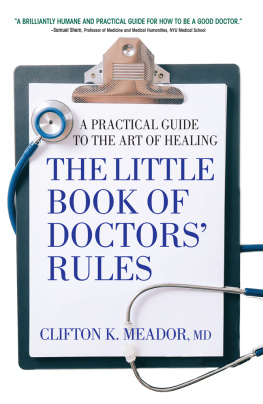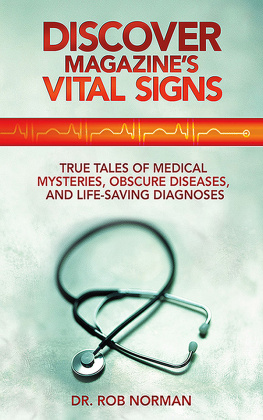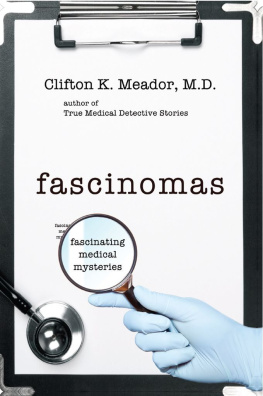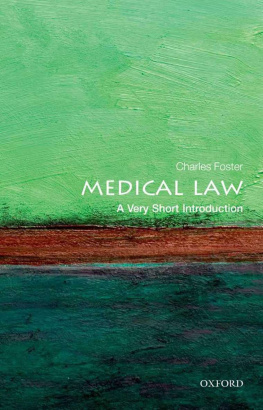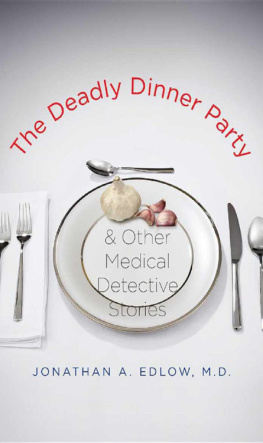
Copyright 2012 Clifton K. Meador, M.D.
All rights reserved.
ISBN: 1475037287
ISBN 13: 9781475037289
eBook ISBN: 978-1-62345-007-6
Library of Congress Control Number: 2012904999
CreateSpace, North Charleston, SC
Other Books
by Clifton K. Meador, M.D.
A_Little Book of Doctors Rules, Hanley & Belfus, 1992
With R. H. Lanius, A Little Book of Nurses Rules, Hanley & Belfis, 1993
With W. Wadlington, Pearls from a Pediatric Practice, Hanley & Belfus, 1998
A Little Book of Doctors Rules II, A Compilation, Hanley & Belfus, 1999
With C. M. Slovis and K. D. Wrenn, A Little Book of Emergency Medicine Rules, Hanley & Belfus, 2000
With W. Wadlington and M. Howington, How to Raise Healthy and Happy Children, iUniverse, 2001
Med School, Hillsboro Press, Providence Publishing Corporation, 2003
Symptoms of Unknown Origin, A Medical Odyssey, Vanderbilt University Press, 2005
Twentieth Century Men in Medicine: Personal Reflections, iUniverse, 2007
Puzzling Symptoms: How to Solve the Puzzle of Your Symptoms, Cable Publishing, 2008
Med School, Revised Edition. Cable Publishing, 2009

Table of Contents
The most beautiful thing we can experience is the mysterious. It is the source of all true art and science.
ALBERT EINSTEIN
To Berton Rouech,
creator of Medical Detective Stories
Berton Rouech, author of Eleven Blue Men and The Medical Detectives, was a childhood hero of mine. My father gave me a copy of Eleven Blue Men when I was a teenager. I read the stories over and over, saying to my father that I wanted to be that kind of doctor when I grew up.
Rouech is best known for his medical detective stories, which were published frequently in the New Yorker beginning in 1944. In the fashion of Sherlock Holmes, he created the genre of the modern medical detective story. He became a regular contributor to the New Yorker with his Annals of Medicine, publishing around two stories a year. He particularly liked medical mysteries that were solved by epidemiological methods.
Rouech read my earlier case report of Dr. Jim, which was published in the New England Journal of Medicine, and called me on the phone. of this book is my version of the case of Dr. Jims Breasts.)
I still puzzle over the irony and coincidence of meeting one of my childhood heroes and actually having him write a clinical case of mine. It was one of the high points of my medical career to meet and get to know Dr. Rouech, even though briefly. He died just a few months after I met him.
Rouechs influences on my practice of medicine and in the writing of this book are large. The medical detective stories and cases in this book are patterned after Rouechs methods of reporting. Mimicry, they say, is the highest form of flattery.
It gives me great pleasure to dedicate this book to the memory of Berton Rouech, the master of medical detective stories.
I want to thank many physician colleagues who shared or discussed their patients clinical stories with me. Among these generous collleagues are Allen Kaiser, William Schaffner, William Hueston, Nortin Hadler, Anderson Spickard, Jr., William Stone, Marc Feldman, and Joseph Merrill. I especially want to thank Alan Graber, who gave suggestions that strengthened the telling of these stories.
Several friends offered constructive help, including Denette and Tom Blankenship, Virginia Fuqua-Meadows, JoniLea Stewart, and Bret Poe. I want to thank my daughter Ann Meador Shayne, an experienced author and editor, for her guidance in the process of making a book. I especially appreciate the efforts of the design team of CreateSpace. The book came to its final form through the fine editing efforts of Mary Neal Meador, wife of my son Clifton.
Many of the stories were first told in some of my other published books. The chapter notes at the end of the book give the primary references for those and other case reports.
Although the clinical features are all true, I have changed the names and identifying characteristics of all the patients and some of the physicians in order to protect their anonymity. Obviously, I have taken liberties with much of the dialogue. The chapter notes acknowledge those physicians who shared clinical stories with me.
I also want to thank my wife, Ann, for her support and editing skills.
I had known Dr. Jim for many years. He practiced in a small town not too far from the city and had sent me a number of patients through the years. He was seventy-six years old and was complaining of breast enlargement when I saw him in 1977. The enlargement had started in the right breast. Because the enlargement was only on one side, it was thought he might have cancer of the breast. The right breast had been removed surgically before Dr. Jim asked me to see him. Cancer of the male breast is not a common lesion, but it does occur and can be quite malignant when it does.
Examination of the breast tissue did not show cancer, but it did show changes typical of gynecomastia. Gynecomastia is the term to describe benign enlargement of the male breast. These changes are indicative of estrogen stimulation. The normally dormant male breast can be converted to a fully functioning female breast if the proper mix of female hormones is present in the bloodstream. The initial finding of one-sided breast enlargement was puzzling. Dr. Jim asked to see me when his remaining left breast had begun to enlarge.
I was not too confounded by the initial one-sided breast enlargement, because I had seen that before. There is sometimes a lag in the response of the breasts, and one will enlarge before the other even though the female hormone is available to both breasts. What did concern me was the appearance of gynecomastia at his age. It usually meant the presence of a malignant tumor of the testicle or the adrenal gland.
At puberty, the normal male secretes both male and female hormones. Enlargement of the breasts in teenage boys is nearly universal if you examine carefully. This early influence of the female hormone is soon replaced by the dominant male hormone, which is secreted in increasing amounts. The effect of the female hormone is inhibited, and the breast enlargement is suppressed. At any time in later life, this same balance can be upset. If enough female hormone is present, breast enlargement will occur in the male at any age.
In the adult male, there are only two sources of female hormones, the testicles and the adrenal glands. Normally, both secrete small amounts of estrogens. Both, however, can develop tumors that are capable of secreting large amounts of estrogens. That was my first concern because these tumors are highly malignantthey grow and spread rapidly. There is a narrow window of time when surgical removal is still curative. In recent years, of course, effective hormone-based chemotherapy has become available for some of these tumors.
There is one other rare cause of estrogen secretion in the adult male: malignant tumors of various organs can curiously begin to make pituitarylike hormones that stimulate the adrenal or testicle to secrete estrogens. Lung cancer is one of these tumors that can produce this bizarre biochemical aberration.
With these ominous and serious possibilities in mind, I ordered all the tests that would identify the presence of estrogens or other hormones that can stimulate estrogen production. All the tests showed the low and normal levels of estrogens typical for a man his age. What a surprise! Knowing that false negative results can occur, I repeated the tests. Again the results came back within normal limits for a male.
Next page
